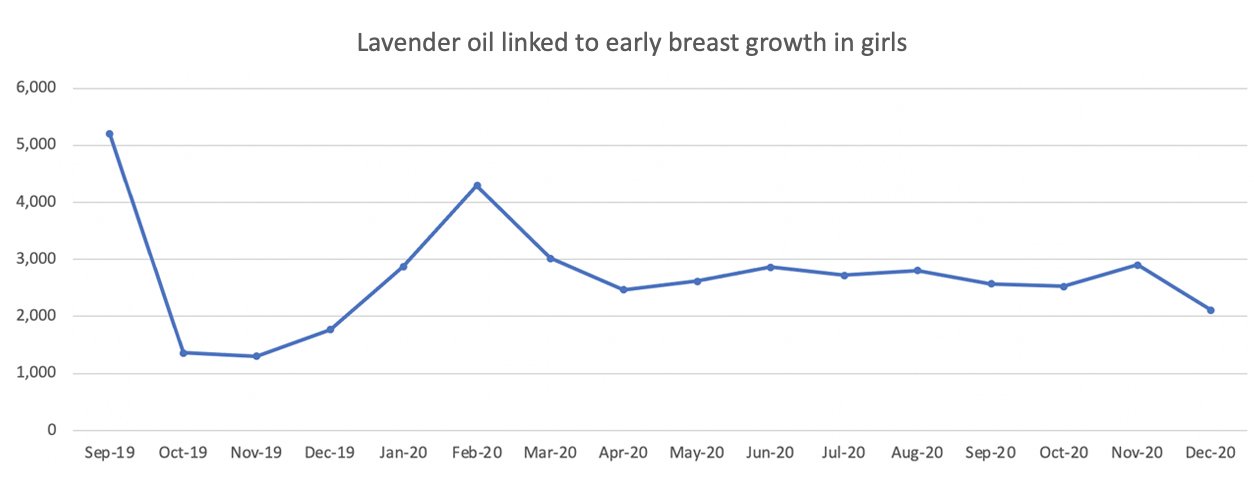 Since late 2013, Lenox has led the Environmental Factor, which in 2017 won Best E-Newsletter from the National Association of Government Communicators. (Photo courtesy of Steve McCaw / NIEHS)
Since late 2013, Lenox has led the Environmental Factor, which in 2017 won Best E-Newsletter from the National Association of Government Communicators. (Photo courtesy of Steve McCaw / NIEHS)A look at the most-read articles in 2020 — regardless of publication date — reveals robust public interest in environmental health topics such as chemicals and consumer products, climate change, health conditions, the scientific endeavor, and not to be overlooked, COVID-19.
For the first time, the NIEHS Environmental Factor has seen one of its articles go viral.
Lavender oil makes the rank
In September 2019, we reported on an NIEHS study that linked compounds in lavender oil and tea tree oil with changes in the endocrine system. That piece has dominated traffic to the newsletter site ever since.
The pattern of monthly views of the lavender oil article indicates that its spread on social media built after initial publication (see chart).
Now, thanks to search engine algorithms that reward web pages receiving lots of traffic, “Lavender oil linked to early breast growth in girls” is the top-ranked result in a Google search for “‘lavender oil’ and girls.” That ranking then encourages more clicks, in a positive feedback loop that has continued for nearly a year and a half. Lavender and tea tree are just two of the essential oils that folks come to the NIEHS website to learn about.
What about 5G?
 The left axis shows average daily views. Right axis plots total views Because earlier articles have had more time to amass views, average monthly traffic provides a better sense of consistent interest. (Image courtesy of NIEHS)
The left axis shows average daily views. Right axis plots total views Because earlier articles have had more time to amass views, average monthly traffic provides a better sense of consistent interest. (Image courtesy of NIEHS)Another hot topic is 5G cell phone technology. In January 2020, an interview with NIEHS toxicologist Michael Wyde, Ph.D., about potential health effects of 5G cell phone technology, grabbed a lot of attention — and continues to.
In “NTP scientist weighs in on 5G technology,” Wyde explained differences between the various generations of cell phone frequencies. As use of 5G technology grows across the United States, people are naturally eager to learn about potential health effects of cell phone radio frequency radiation. Because health effects of 5G are yet unclear, Wyde described upcoming studies to look for effects in exposed rodents.
The list
The most popular articles in 2020, regardless of when they were published, are listed below. Five appeared in 2019, suggesting sustained interest in their topics.
Sharp-eyed subscribers may notice that the list has been updated from the one they received in January (see sidebar for more on subscribing). The publication date follows the hyperlinked title.
Happy reading!
- Pollution is a global but solvable threat to health, say scientists (January 2019)
- Endocrine disruptor identification begins with biology (December 2019)
- PFOA evaluated for cancer links by NTP expert panel (January 2020)
- 2019 Papers of the Year (January 2020)
- Chemical used in sunscreen analyzed for potential carcinogenicity (January 2020)
- From science to innovation — 2019 tech breakthroughs (January 2020)
- Permanent hair dye and straighteners may increase breast cancer risk (January 2020)
- Microplastics research needs innovation, health focus (March 2020)
- Vaping has measurable effects on the body, unclear if safer than smoking (November 2019)
- Fighting COVID-19 using data science (June 2020)
- The environment influences brain development, experts say (March 2020)
- PFAS — a problem in North Carolina drinking water (March 2019)
- Innovative ALS research fueled by $25 million from NIH (July 2020)
- No clear guidelines on self-plagiarism in science, Moskovitz says (July 2020)
- Autoimmunity may be rising in the United States (May 2020)
- Latest autism research makes progress toward biomarkers (April 2020)
- COVID-19 shines light on Navajo water contamination (June 2020)
- Climate change worsens air pollution, extreme weather, expert says (July 2020)
- NTP scientist weighs in on 5G technology (January 2020)
- Lavender oil linked to early breast growth in girls (September 2019)










